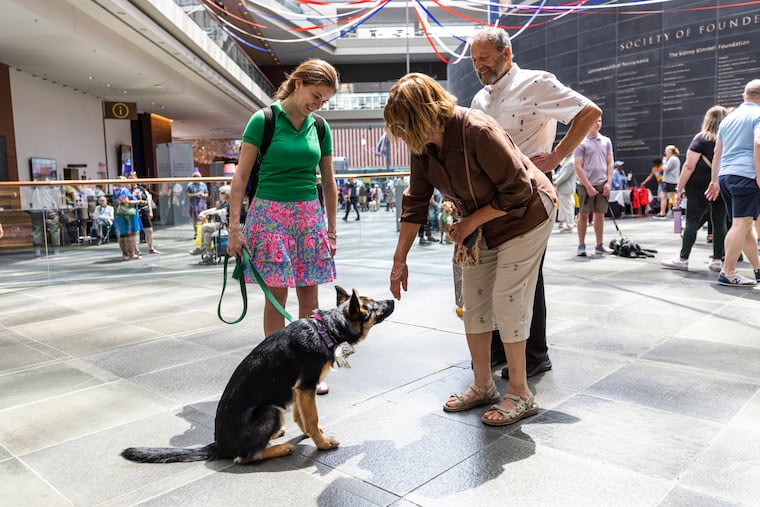The Philadelphia Orchestra played beautifully Saturday. But who let the dogs in?
Eight puppies were schooled in concert etiquette on the way to becoming guide dogs.

They came, they listened, and barely a bark was heard. Which is something that can usually go safely unremarked at a Philadelphia Orchestra concert.
But for Saturday’s matinee, in addition to a couple of thousand fans of patriotic music, the orchestra drew eight puppies getting their first-ever morsels of world-class orchestral music, and the audience cuteness quotient soared.
There they sat or sprawled near the seats occupied by their humans as the music played: Ridge and Ryer; Charlie, Holly and Dodger; Eastwood and Daphne; and Samantha, a 5-month-old German shepherd with big ears and probing, expressive eyes.
Saturday’s concert in Marian Anderson Hall was a free program for the usual orchestra fans, which is to say, two-legged ones. But it was also a chance for a select pack of canines to learn how to behave at a concert on their way to training as guide dogs.
“We’ve never really been able to take a dog to something as spectacular as a concert like this,” said Kalie Desimone, who attended with Samantha. Samantha and the other dogs will live with their host families until they’re about 15 months old before eventual placement with blind and sight-impaired clients.
It’s likely that concert attendance will be a part of the work for many of the dogs, Desimone said.
“Surprisingly or not, the blind people the dogs are paired with, a lot of them are musicians or they love music.”
It was Jeremy Rothman, the orchestra-Kimmel Center artistic and programming chief, who invited them in. His own family puppy sat for a family raising one for the Seeing Eye, based in Morristown, N.J., and his wife, Catherine VanVlack, suggested that the nonprofit organization might be interested in giving their young wards some concert experience.
“I mentioned it at a staff meeting, and everyone was like, ‘Dogs!’” said Rothman.
The Seeing Eye puppies learn basic house manners and socialization with their host families before going on to formal training and their match with clients. The group provides the host families with various kinds of support, including covering veterinarian bills and giving a stipend for food.
“It’s not only a great opportunity for our dogs,” said Seeing Eye area coordinator Shannon Rager of Saturday’s concert, “but we always need puppy sitters and puppy raisers, and this is a great way to show people who may not know about us what we do.”
At this point, Desimone is an old hand at it. Samantha is the 15th puppy she has raised.
“She’s incredibly loving. We call her a snuggle-bug. She’s very much attached to us, like Velcro.”
The feelings go both ways, and the eventual parting, painful though it may be, comes with some consolation.
“When I give her up, she lives on at the same age in my head,” said Desimone.
Saturday was perhaps a good test for what might lie ahead for any dogs with concerts in their future. Classical music can be mellow, of course, but not everything is as chill as a Satie Gymnopédie or Mozart serenade. And many scores go from shimmering strings to cymbal crash with no warning, which could startle a dog as it would a human. What then?
“Our families are good about reading a dog’s body language,” said Rager. “If your dog is not happy, you remove the dog from that situation, because we don’t want to create a stressful environment.”
But at Saturday’s nearly two-hour concert of Copland, John Williams and Sousa led by conductor Jeff Tyzik, no one seemed stressed. All the dogs were quiet during the music. Samantha, though, did look concerned at one point. Tyzik had asked the audience to whistle along during the Colonel Bogey March, and when they did, Samantha sat up as if to see what all the noise was about. She let out a few barks on the way out to intermission.
But for the most part, she was everything you’d want a concert companion to be, and considerably more adorable than most.
Said Desimone:
“This was a very big deal for her. She was awesome.”